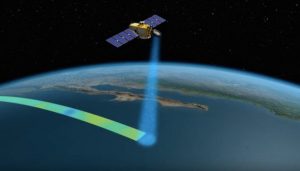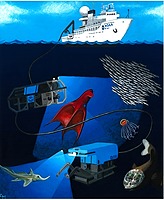World of Water
This program is a collaboration between the Cape Cod Regional STEM Network and Woods Hole Sea Grant.
Summary
In this 2nd grade unit, the students will learn about the different bodies of water found on the earth’s surface. The students will use resources to explain that water is found on earth in different areas. Students will compare and contrast the different bodies of water. At the end of the unit, they will be able to identify the characteristics of each body of water including size, salt or freshwater, and liquid or solid.
NOAA Live! Webinars Highlighted: The Ocean From Space, Onward and Downward! Exploring the Deep Ocean, Helping Big Ships Bring Goods Into Port So You Can Have What You Need, Swimming Upstream with River Herring, The Life of Hawaiian Bonefishes
Lesson Plan
Activity Sheets/Handouts
This lesson meets the following Standards:
- NGSS:
-
- 2-ESS2-2 - Develop a model to represent the shapes and kinds of land and bodies of water in an area.
- 2-ESS2-3 - Obtain information to identify where water is found on Earth and that it can be solid or liquid.
- MA STE:
-
- 2-ESS2-2 - Map the shapes and types of landforms and bodies of water in an area.
Clarification Statements:
Examples of types of landforms can include hills, valleys, riverbanks, and dunes.
Examples of water bodies can include streams, ponds, bays, and rivers.
Quantitative scaling in models or contour mapping is not expected. - 2-ESS2-3 - Use examples obtained from informational sources to explain that water is found in the ocean, rivers and streams, lakes and ponds, and may be solid or liquid.
- 2-ESS2-2 - Map the shapes and types of landforms and bodies of water in an area.
- Ocean Literacy Principles:
-
- The Earth is one big ocean with many features
- a- The ocean is the defining physical feature on our planet Earth—covering approximately 70% of the planet’s surface. There is one ocean with many ocean basins, such as the North Pacific, South Pacific, North Atlantic, South Atlantic, Indian, Southern, and the Arctic.
- g - The ocean is connected to major lakes, watersheds, and waterways because all major watersheds on Earth drain to the ocean. Rivers and streams transport nutrients, salts, sediments, and pollutants from watersheds to estuaries and to the ocean.
- The Earth is one big ocean with many features
List of Unit Resources
This program is a collaboration between the Cape Cod Regional STEM Network and Woods Hole Sea Grant.
Teacher in Residence
Michael Irving
3rd Grade Teacher
North Falmouth Elementary School
Michael Irving worked with the Woods Hole Sea Grant Educator at the Woods Hole Oceanographic Institution during July of 2020, developing four different lesson plans that included both in-person and remote learning lessons and activities. The lessons include information and clips from more than a dozen NOAA Live! Webinars.







